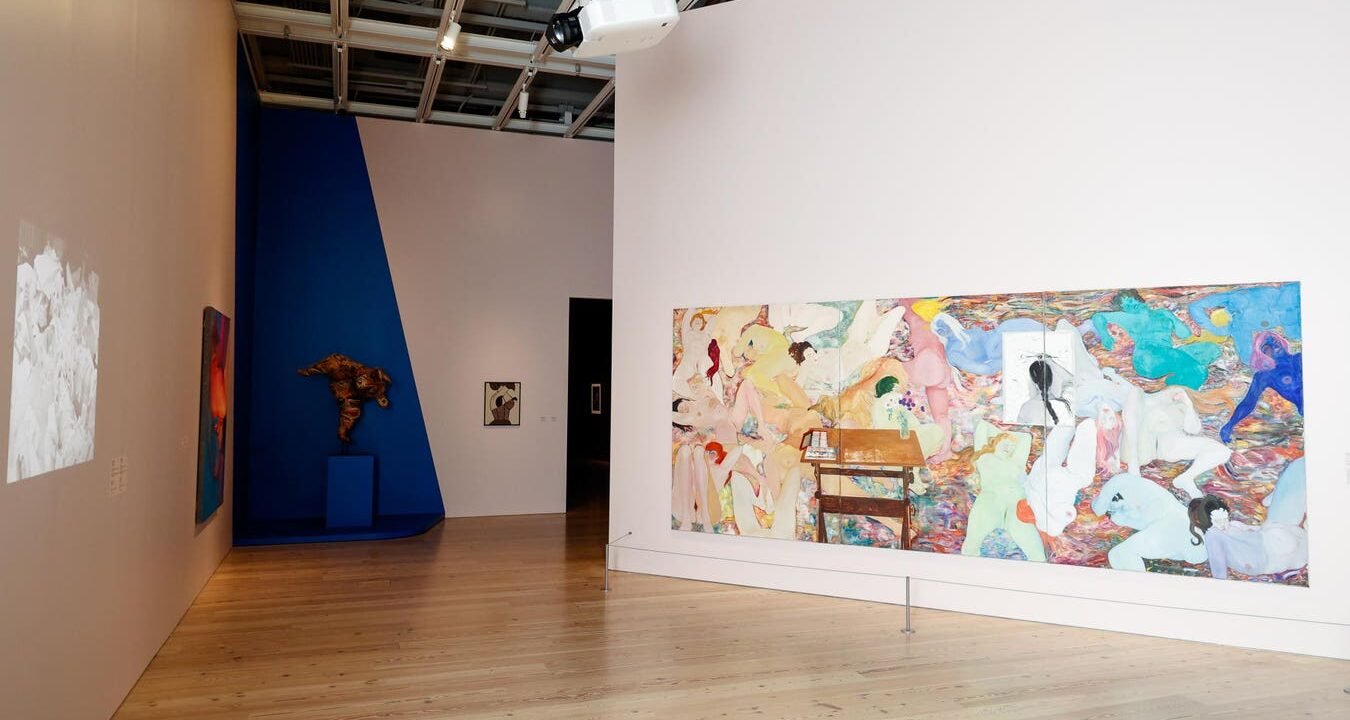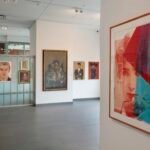
Installation view of Sixties Surreal (Whitney Museum of American Art, New York, September 24, 2025–Jan 19, 2026). From left to right: Carolee Schneemann, Body Collage, 1967; Joan Semmel, Untitled, 1971; Niki De Saint Phalle, Vivian, 1965; Christina Ramberg, Shadow Panel, 1972; Martha Edelheit, Flesh Wall with Table, 1965. Photograph by Quadir Moore/BFA.com. © BFA 2025
Quadir Moore/BFA.com
Twenty reclining female nudes sprawl across three monumental canvases, painted in an array of unusual fleshy hues such as deep blue, teal, moss green, and mauve pink. The intermingling of platonic and erotic love creates a utopian sapphic narrative born from the artist’s imagination, evoking a dreamy fantasy.
While Martha Edelheit (born 1931) typically painted from individual live models whose bodies she combined in the final composition, the triptych Flesh Wall With Table (1965) deviates from that process. Edelheit’s fantastical scene rejects the male gaze and inserts her into the conversation with a self portrait overlapping the middle and right panels. Edelheit portrays herself painting a simple floral canvas, her long dark braid flowing down her spine, and constrained by a black, grey, and white rectangle that juxtaposes with the vivid, elaborate visual narrative.
Edelheit may be hinting at communal living, which emerged in the 1960s as a widespread counterculture movement that embraced cooperative, self-sufficient living and shared resources. Though she was married twice to men and has not openly identified as queer, Edelheit is clearly celebrating women’s liberation and non-normative notions of feminine sexuality during a turning point for women’s reproductive rights. In 1965, the U.S. Supreme Court decision Griswold v. Connecticut established a constitutional right to privacy regarding contraception for married couples. But Edelheit’s conversation goes beyond the social advances of the time, opening a dialogue that’s as urgent as ever amid a political attack on basic human rights.
While the New York-born artist living in Sweden is characterized as a feminist who painted erotic art in the 1960s and 1970s, Edelheit has been fluid across genres, and Flesh Wall With Table celebrates female desire, the body, and identity by subverting realism with the various poses, including some figures who appear to float or achieve impossible contortions.
Flesh Wall With Table transcends labels, finding its way into the Whitney Museum of American Art’s Sixties Surreal, a blockbuster exhibition that redefines American art from 1958 to 1972 through the lens of the “surreal,” both inherited and reinvented. Opening to the public tomorrow, the ambitious exhibition showcases 111 artists who, through a diverse range of styles and techniques, magnified the psychosexual, fantastical, and revolutionary ethos of a period of significant social, political, and cultural upheaval that transformed society. Sadly, many of those hard-earned human rights are precarious today, underscoring the timeliness and relevance of the themes being explored.
Edelheit is joined by fellow proto feminists, including Barbara Hammer, Luchita Hurtado, and Shigeko Kubota, whose work was too often undermined by the moniker “erotic art,” diluting their powerful and profound social messages.
“This show was really taking the idea of the surreal with a little case ‘s’. It’s a word in Webster’s, I promise, that kind of suggests a weird and bizarre alternative to reality as we supposedly know it, and what we found in looking at the 60s, and in particular, a group of artists mostly born after 1930,” explained Scott Rothkopf, the Alice Pratt Brown Director of the Whitney Museum. “Our show begins in 1958 and it ends in 1972, and we kept trying to extend it a little bit more and more.”
Sixties Surreal goes beyond the familiar movements of the 1960s like Pop Art, Conceptualism, or Minimalism, using “surrealism” to uncover alternate histories and re-contextualize some of the decade’s most renowned artists alongside those who have been underrepresented in the art world. By examining art that is disorienting, illogical, or fantastic, Sixties Surreal isn’t bound by the 20th-century avant-garde art and literature movement, which unleashed the creative potential of the unconscious mind. These works are consciously exposing the social problems of a tumultuous decade that gave rise to a wildly influential counterculture movement.
Installation view of Sixties Surreal (Whitney Museum of American Art, New York, September 24, 2025–Jan 19, 2026). Photograph by Quadir Moore/BFA.com © BFA 2025
Quadir Moore/BFA.com
“For this generation of artists … born largely after 1930 in all different parts of America, they were not necessarily interested in that march of isms … or if they were interested in it, they were interested in critiquing and expanding beyond it,” said Rothkopf. “What we came to think of was how across this country, from the Bay Area to New York, Texas, Chicago, artists were looking to surreal ways of picturing a world that, to them, had become surreal. This was a time, of course, when there was the threat of nuclear annihilation. There was the Vietnam War. There were many different liberation and protest movements that were happening. People had TVs at the foot of their beds. That’s a kind of weird new thing to experience, if you’re not used to having a moving picture like that in your home. Obviously, there was a psychedelic drug culture that was brewing, and so many more developments in contemporary society that led artists to maybe look beyond some of those isms as we knew them, and find again, this new way of picturing their experience and their reality.”
While serious themes are explored throughout the exhibition, which features curved installation platforms and colored walls to set the mood, humor and playfulness are infused throughout.
Installation view of Sixties Surreal (Whitney Museum of American Art, New York, September 24, 2025–Jan 19, 2026). From left to right: Lynn Hershman Leeson, Giggling Machine, Self Portrait as Blonde, 1968; Christina Ramberg, Shadow Panel, 1972; Nancy Graves, Camel VI, Camel VII and Camel VIII, 1968–1969; Marisol, Women and Dog, 1963-64; Luchita Hurtado, Untitled, 1971. Photograph by Quadir Moore/BFA.com. © BFA 2025
Quadir Moore/BFA.com
Painting, collage, carving, and assemblage collide to create Marisol’s whimsical Women and Dog (1963–1964). Marisol was among the few women immersed in New York’s Pop Art movement, and her bizarre wood, plaster, synthetic polymer, and taxidermic dog head sculpture plays along with the quotidian obsessions of Pop Art, while amplifying the narrative with enormous totemic figures, including two with multiple faces, borrowing from Pre-Colombian and Native American folk art and Cubism. Three women, a dog, and a child are engaged in everyday life, but how are they related? Like Edelheit, Marisol (b. 1930, Paris; d. 2016, New York) inserts herself into the artwork, applying a photograph of herself onto one of the faces. Imagine David Bowie thinking of this ensemble when he wrote the lyrics to his lavish ballad, “Life on Mars?” (1971): “my mother, my dog, and clown.”
The tone for the exhibition is set when viewers are greeted on the fifth floor by Nancy Graves’ three life-sized wood, steel, burlap, polyurethane, animal skin, wax, and oil paint Camels (1968-1969). It’s a homecoming for the hoofed mammals, who first appeared in a 1969 solo exhibition at the Whitney’s former home in the Breuer building. The pseudo-realistic Camels subverted Minimalism and Pop Art, opening the conversation for Sixties Surreal.
“These camels are meant to signal that this is not your history book surrealism. It’s a show about disorientation and a new attempt to convey meaning through uncannily reconfigured objects and ideas in space,” explained Dan Nadel, the Steven and Ann Ames Curator of Drawings and Prints at the Whitney.
Installation view of Sixties Surreal (Whitney Museum of American Art, New York, September 24, 2025–Jan 19, 2026). From left to right: Nancy Graves, Camel VI, Camel VII and Camel VIII, 1968–1969; Jean Conner, Are You a Springmaid? II, 1960; Jean Conner, Are You a Springmaid?, 1960; Paul Thek, Untitled from the series Technological Reliquaries, 1966; Jim Nutt, Running Wild, 1969-1970; Claes Oldenburg, Soft Toilet, 1966; Lee Lozano, No Title, 1964. Photograph by Quadir Moore/BFA.com © BFA 2025
Quadir Moore/BFA.com
Each gallery installation of the immersive exhibition seems eerily contemporary, as Americans confront the same feelings and reactions to sociopolitical turmoil, as our “society” and “culture” become increasingly retrograde. More than ever, there is a dire need to look to the arts for solace, inspiration, and escape.
A gallery “we’re calling social surreal, which is focused on artists, photographers in particular, who were looking outside of their selves, maybe moving out of that body ego and looking into everyday American life, seeing that it was off kilter, that it was weird, that it was, as Scott mentioned, small ‘s’, sort of vernacular, surreal,” said Laura Phipps, assistant curator at the Whitney Museum of American Art. “And this recognition of surrealism, proximity to reality, was pointed out by artists like Edward Owens, who is capturing moments on the streets in the city of New York, as well as in works like Luis Jiménez’s Blond TV Image, which is really addressing the sort of unnerving presence of televisions in the home (of) this the post-war life that’s being transmitted into everyone’s living rooms is really changing a relationship with reality.”
Owens and Jimenez are among the artists who help to present a comprehensive look at American art across states and cultural perspectives, demonstrating how many diverse practices emerged in response to the decade.
While Owens (1949-2009) was born and died in Chicago, the queer Black artist worked as an experimental filmmaker in Chicago and New York during the 1960s and helped to shape the underground “New American Cinema” movement. Owens rose to prominence alongside artists like Jonas Mekas, Stan Brakhage, and Andy Warhol, striving to create experimental, personal, and non-commercial films. Opposing mainstream Hollywood conventions, the movement advocated for artist-run distribution through the Film-Makers’ Cooperative and featured shocking content to usher in a decade of fierce rebellion.
Installation view of Sixties Surreal (Whitney Museum of American Art, New York, September 24, 2025–Jan 19, 2026). From left to right: Peter Saul, Saigon, 1967; Daniel LaRue Johnson, Freedom Now, Number 1, August 13, 1963 – January 14, 1964, 1964; Benny Andrews, No More Games, 1970; Timothy Washington, TK (Viet Nam), 1970; Jasper Johns, Flags, 1965; Harold Stevenson, The New Adam, 1962; Ralph Arnold, Unfinished Collage, 1968; Mel Casas, Humanscape #56 (San Antonio Circus), 1969; T.C. Cannon, Andrew Myrick – Let Em Eat Grass, 1970; Luis Jimenez, Man on Fire, 1969; Fritz Scholder, Indian and Rhinoceros, 1968; Judith Bernstein, Vietnam Garden, 1967; Barbara Jones-Hogu, Mother of Man, 1968. Photograph by Quadir Moore/BFA.com. © BFA 2025
Quadir Moore/BFA.com
Jiménez (b. 1940, El Paso, Texas; d. 2006, Hondo, New Mexico) was a sculptor and teacher, who created large fiberglass figures to convey narratives of Hispanic-American people. His works in Sixties Surreal include Man on Fire (1969–1970), made of fiberglass with urethane finish on painted fiberboard base, to form a larger than life-size sculpture inspired by Jose Clemente Orozco’s 1938–1939 dome painting in the Cabanas Orphanage in Guadalajara, Mexico. Jiménez retells the story of Cuauhtemoc, the last Aztec emperor and an enduring symbol of national pride in Mexico who was tortured to death with fire by the Spaniards soon after the Conquest of Mexico in 1521, while incorporating the visceral demise of Vietnamese Mahayana Buddhist monk Thích Quảng Đức, who set himself on fire in 1963 at a bustling Saigon intersection to protest the persecution of Buddhists by the South Vietnamese government.
“Ooh, that’s scary!” exclaimed a viewer during member previews.
Augment your journey at home, with Sixties Surreal, a scholarly publication that complements the exhibition by chronologically following the artists, while the show itself is arranged by theme.
Under Rothkopf’s leadership, the Whitney is committed to making art more accessible to broader audiences by offering more opportunities for free admission and including a series of free in-person and virtual public programs in conjunction with Sixties Surreal. Admission is always free to visitors 25 and younger, and free for everyone every Friday from 5–10 p.m. and on the second Sunday of every month.
“We want to drive these audiences,” said Rothkopf. “We’ve seen a three-fold increase of our 19- to 25-year-olds in just something like six or seven months. That’s just extraordinary.”
There is no excuse to miss Sixties Surreal, which is years in the making and organized by Nadel, Phipps, Rothkopf, and Elisabeth Sussman as curator, with Kelly Long as senior curatorial assistant, and Rowan Diaz-Toth as curatorial project assistant. The exhibition is on view until Jan. 19, 2026.










